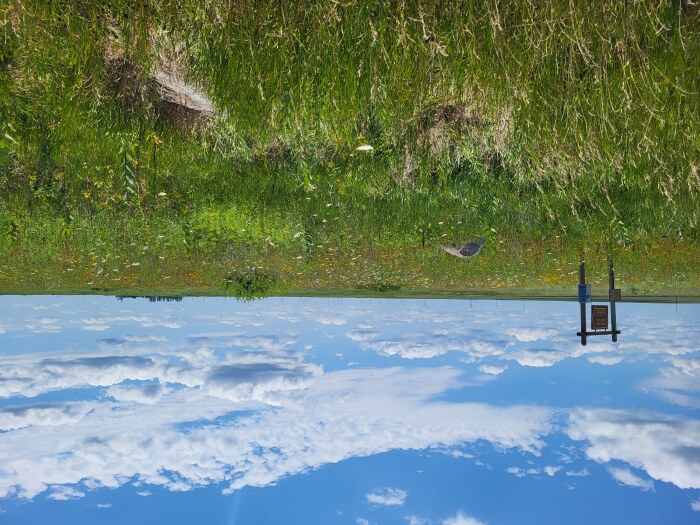Kara Grady is a wildflower enthusiast living in eastern Iowa. Her work has been published in the Erythronium newsletter of the Iowa Native Plant Society. When she’s not going on rare flower adventures, she can be found reading the latest botanical books or attending prairie seminars.
First off, I need to thank Kenny Slocum for letting me borrow his “KAPAI” branding. It wasn’t until I read his “Notes from a prairie tour across Iowa” and related “KAGPAI” articles (for “Kenny’s Annual Great Prairiestomp Across Iowa”) that I realized I had done my own prairie tour, featuring some of the most niche ecosystems Iowa had to offer.
Mine began in late April with an hour-long trip to the Hamilton-Tapken Prairie Preserve north of Onslow (Jones County). It was a hopeful attempt to find pasque flowers, the flowers that led to Ada Hayden meeting her lifelong mentor and friend Louis Pammel. But I missed them and instead ended up roaming the brown hills fruitlessly. Instead, I stumbled upon a single cluster of early blue violets, one of the host plants of the endangered regal fritillary butterfly.

Early blue violets
Next was Dr. Thomas Rosburg’s woodland hike at Big Rock Park in Pella. We found the unmottled leaves of the rare Prairie Trout Lily, pink Wood Sorrel, a baby Green Dragon, and the purple blooms of Jacob’s Ladder.

Leaves of prairie trout lily

Pink wood sorrel

Baby green dragon

Jacob’s ladder flowers
We took photos of each other against the big rock and talked about different ways to manage the invasive garlic mustard that was taking over the understory.

Kara Grady with the big rock
Towards the end of the hike, to our group’s surprise and delight, we came across a several morels growing amongst some decaying wood. I took one home and sauteed it with some veggies. It was a melt-in-your-mouth experience.


After an orchid adventure at Beam Woods and a penstemon discovery at Morgan Creek Park, it was time to embark on my first Annual Loess Hills Seminar: Head for the Hills. I was ecstatic to be a part of Kelly Madigan’s Writers Group, but going on Chris Helzer’s Prairie Hike was the real treat.


It was my first time seeing the famous yucca plant. As most of the prairie wasn’t yet in bloom, our group fell to discussing the differences among leaves of the plants and the pollinators that were already abundant.

Yucca blooming

Chris Helzer with young Dalea & Asclepias plants
By the end of the week, I was on the other side of the state, attending the Big Sand Mound Field Day south of Muscatine. The preserve is home to many rare plants and animals, and therefore is only open to the public every three years.

Following Dr. Rosburg into the dunes, our group marveled over hoary puccoon, yarrow, rare green milkweed, prairie sage, wild rose, prairie larkspur, eastern prickly pear, and many kinds of sedges.






Prairie larkspur

Eastern prickly pear cactus
Coming across a few ornate box turtles, another endangered species, led to more intense discussion of the ecology of the dunes and how they could best be preserved and expanded.

As we made our way down to the lake, I sniffed the air. A familiar peppery scent led me to a patch of spotted bee balm, my own discovery of the day.

Mid-June found me driving up to Split Rock Park in the hopes of finding the small white lady slipper. Once again, a fruitless search led to unexpected surprises as I came upon my first sedge meadow. The sedges rippled in the wind in undulating waves, bordered by fading wild roses, golden Alexanders, and new-to-me meadow phlox.


Faded wild rose


Meadow phlox
At the end of July, driving north to Rochester, I nearly slammed the brakes when I saw a brown sign with the words “Hayden Prairie.” I’d been to Kalsow several times last year collecting seed for the Iowa Department of Natural Resources, and the idea that I could finally visit both of the prairie preserves that were set aside during Ada Hayden’s lifetime filled me with joy.
After a weekend visit to my aunt and sister, I drove back south. Parking by the road, I read the plaque that designated the prairie as a Natural Landmark in 1966.

Another sign read that the prairie was “named in honor of Dr. Ada Hayden [and] is one of Iowa’s largest and best tallgrass virgin prairie preserves.”

Wading into the grass, I found the yellow sunflowers beginning to open. Drooping common milkweed mixed with upright gray-headed coneflower.

Sunflower opening

Common milkweed

The prairie was a blaze of yellow and white, mainly due to an invasion of Queen Anne’s lace. It made me wonder if yellow was a favorite color of Ada’s. Having read through her personal correspondence with Pammel from the Iowa State Special Collections (in preparation for writing her first biography!) and seen her set of colored lantern slides, I believe she loved the whole palette of gorgeous prairie colors.

These prairies are just a taste of the adventures I’ve had in Iowa this year. I’m excited to share more as I continue to explore our wonderful state!

All photos by Kara Grady were provided by the author and published with permission.


1 Comment
Thank you very much...
…for taking us along on your Stomp!
PrairieFan Sun 27 Aug 7:28 PM